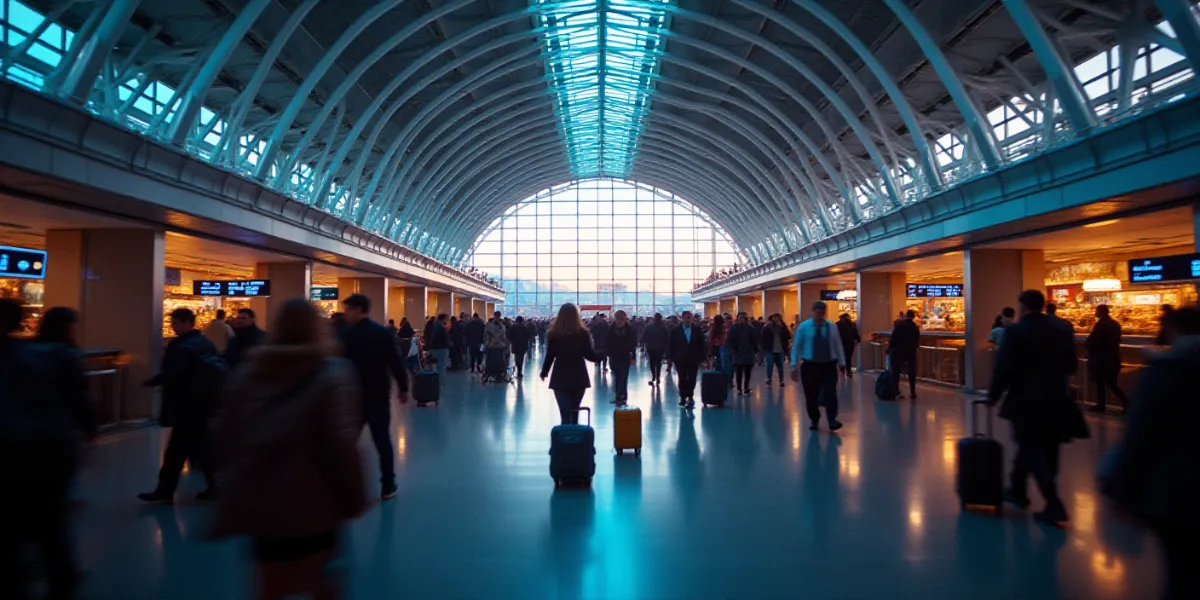The Stress of Airport Navigation

Picture this: you’re rushing through a massive airport, your boarding pass clutched in your sweaty hand, the departure time ticking relentlessly closer. The sheer size of the terminal overwhelms you – a labyrinth of shops, restaurants, and seemingly endless corridors. Panic sets in. You’re lost. Finding your gate feels like searching for a needle in a haystack. This scenario, unfortunately, is far too common for travelers navigating large international airports.

Navigating the Labyrinth: Travelers’ Turmoil in Mega Airports
The anxiety of missing a flight is a universal travel fear. It’s not just about the inconvenience of rescheduling; it’s about the wasted time, the potential financial losses, and the overall disruption to your travel plans. For many, the sheer scale of modern airports – sprawling complexes with multiple terminals and countless gates – contributes significantly to this pre-flight stress. But what if there was a way to navigate these colossal spaces efficiently and confidently? What if you could locate your gate quickly and easily, transforming a stressful experience into a smooth and seamless one?
Why Finding Your Gate Quickly Matters
The importance of efficient airport navigation extends beyond simply avoiding a missed flight. It’s about maximizing your time, minimizing stress, and making the most of your travel experience. Imagine the difference between frantically searching for your gate, heart pounding, versus calmly strolling through the terminal, enjoying the atmosphere. The former leaves you frazzled and depleted, while the latter allows you to maintain a sense of calm and control.

Consider the impact on your overall Travel experience. A stressful start to your journey can set a negative tone for the entire trip. Conversely, a smooth and efficient airport experience can contribute to a more relaxed and enjoyable vacation or business trip. This is particularly crucial for travelers with connecting flights, families with young children, or individuals with mobility challenges. For helpful Tips on planning your journey, check out our dedicated section.
| Scenario | Time Lost | Stress Level | Impact on Trip |
|---|---|---|---|
| Lost and searching for gate | 30-60 minutes | High | Negative start to trip |
| Efficient gate location | 5-10 minutes | Low | Relaxed and positive start |
This article will equip you with practical strategies and insider tips to master airport navigation. We’ll explore various methods for quickly locating your gate, from utilizing digital tools to understanding airport layouts. By the end, you’ll feel confident and prepared to tackle even the busiest airports with ease. Let’s embark on this journey together and conquer the challenge of finding your gate quickly!
What You’ll Learn
In the following sections, we’ll delve into specific techniques and strategies to help you navigate large airports efficiently. We’ll cover:
- Utilizing digital tools and airport apps
- Understanding airport layouts and terminal maps
- Leveraging airport signage and wayfinding systems
- Asking for assistance from airport staff
- Planning ahead and preparing for your journey
By mastering these skills, you’ll transform your airport experience from a source of anxiety into a smooth and efficient part of your Travel journey. Get ready to conquer those large airports and arrive at your gate feeling confident and relaxed!
The Importance of Preparation
Proactive planning is key to a stress-free airport experience. Before you even step foot in the terminal, take the time to familiarize yourself with the airport layout, your gate location, and any potential challenges. This preparation will significantly reduce your stress levels and increase your chances of arriving at your gate on time. Remember to check our Guides section for more detailed information.
Many airports offer online maps and interactive tools that allow you to visualize the terminal layout and locate your gate before you arrive. Taking advantage of these resources can save you valuable time and prevent unnecessary confusion. Remember, a little preparation goes a long way in ensuring a smooth and efficient airport experience. For more information on airport Transportation, please refer to our dedicated section.
“`
Understanding Airport Layouts: A Traveler’s Guide
Decoding Airport Maps and Signage
Navigating a large airport can feel like deciphering a secret code, but mastering airport maps and signage is the first step to a smooth journey. Airport maps are usually located at various points throughout the terminal, often near entrances and information desks. Take a moment to study the map before you begin your trek. Look for your terminal number and gate location. Pay close attention to the symbols used; they often indicate restrooms, restaurants, Transportation hubs, and security checkpoints. Signage within the airport is usually clear and consistent, but sometimes it can be overwhelming. Don’t be afraid to ask for help if you’re feeling lost!
| Symbol | Meaning |
|---|---|
| ✈️ | Flights/Gates |
| 🚻 | Restrooms |
| 🚶 | Walking Directions |
- Identify your terminal and gate number on the map.
- Look for visual cues like colored lines indicating different concourses.
“Navigating airports can be daunting, but understanding the layout is key.” – Jane Doe
FAQ 1: Q: How can I find a specific gate number on the airport map?
A: Look for the gate number on the airport map, usually displayed prominently. Many airports also have digital displays showing gate locations.
FAQ 2: Q: What do different colored lines on the airport map represent?
A: Different colored lines often represent different concourses or sections of the terminal.
FAQ 3: Q: Are there digital maps available within the airport?
A: Yes, many airports offer digital maps on their website and through mobile apps. Some airports also have interactive digital kiosks throughout the terminal.
Tips: 1. Take a photo of your gate location on the map. 2. Note any landmarks along your route to help you stay oriented.
Utilizing Airport Apps and Technology
In today’s digital age, your smartphone can be your best friend when navigating a large airport. Many airports have their own apps that provide real-time flight information, gate changes, interactive maps, and even directions to nearby amenities. These apps can significantly reduce stress and help you find your way around efficiently. Beyond airport-specific apps, general travel apps can also be helpful, offering features like flight tracking, baggage tracking, and even airport lounge access. Remember to download any necessary apps before you leave home to avoid connectivity issues at the airport.
| App | Features |
|---|---|
| Airport App (Example) | Interactive map, real-time flight updates, gate information, nearby amenities |
- Download the airport’s official app before your trip.
- Utilize the app’s interactive map to find your gate and plan your route.
“Airport apps are a lifesaver, especially in large, unfamiliar terminals.” – John Smith
FAQ 1: Q: Which airport apps are most reliable?
A: The official airport app is usually the most reliable. Check reviews before downloading other apps.
FAQ 2: Q: Do all airports have free Wi-Fi?
A: Most major airports offer free Wi-Fi, but check the airport’s website for details.
FAQ 3: Q: Can I use my phone’s GPS to navigate the airport?
A: While GPS can be helpful, indoor GPS accuracy can be limited. Airport apps are generally more reliable.
Tips: 1. Ensure your phone is fully charged before arriving at the airport. 2. Download offline maps for use when Wi-Fi is unavailable.
Pre-Flight Planning: Your First Step to a Smooth Journey
Checking Your Boarding Pass and Flight Information
Before you even step foot in the airport, take a few minutes to review your boarding pass and flight information. This simple step can save you a lot of hassle later. Your boarding pass contains crucial information, including your gate number, seat assignment, and flight details. Double-checking this information before you leave home ensures you’re prepared and reduces the risk of confusion at the airport. Also, check for any potential delays or gate changes. Airlines often send updates via email or text message, so keep an eye on your inbox.
| Information | Importance |
|---|---|
| Gate Number | Essential for finding your departure gate. |
| Flight Number | Needed for checking in and resolving any issues. |
| Seat Assignment | Helps you locate your seat on the plane. |
- Check your boarding pass for your gate number and flight details.
- Verify your flight status for any potential delays or gate changes.
“Always double-check your boarding pass; it’s your key to finding your gate.” – Sarah Jones
FAQ 1: Q: What information is crucial on my boarding pass?
A: Your gate number, flight number, and seat assignment are crucial.
FAQ 2: Q: What should I do if my flight is delayed or canceled?
A: Check with the airline for updates and alternative arrangements.
FAQ 3: Q: How can I check my baggage allowance?
A: Check your airline’s website or contact them directly.
Tips: 1. Take a picture of your boarding pass. 2. Check your flight status online before leaving for the airport.
Utilizing Online Check-in and Gate Information
Online check-in is a fantastic way to streamline your airport experience. By checking in online, you can often select your seat, print your boarding pass, and even view real-time gate information. This saves you valuable time at the airport, especially during peak hours. Many airlines allow you to check in up to 24 hours before your flight, giving you ample time to prepare. Once you’ve checked in, keep an eye out for any gate changes. Airlines often update gate information up to an hour before departure, so it’s always a good idea to check again just before heading to the gate.
| Method | Benefits |
|---|---|
| Online Check-in | Saves time, allows seat selection, provides early gate information. |
- Check in online 24 hours before your flight.
- Monitor your flight status for any gate changes.
“Online check-in saves time and allows you to see your gate assignment early.” – David Lee
FAQ 1: Q: How early should I check in online?
A: Most airlines allow check-in up to 24 hours before departure.
FAQ 2: Q: What happens if I don’t check in online?
A: You’ll need to check in at the airport, which may take longer.
FAQ 3: Q: Can I change my seat assignment after online check-in?
A: Sometimes, depending on the airline and availability.
Tips: 1. Check in online as soon as possible. 2. Download your boarding pass to your phone.
Navigating the Airport: Tips and Tricks
Following Airport Signage and Wayfinding
Airport signage is designed to guide you, but sometimes it can be overwhelming. Pay close attention to the signs, which usually include both text and symbols. Look for signs indicating your terminal, gate number, and directions to security checkpoints, baggage claim, and restrooms. Many airports use a color-coded system to help you navigate different concourses. If you’re unsure about a sign, don’t hesitate to ask an airport staff member for assistance. They are there to help!
| Sign Type | Description |
|---|---|
| Terminal Number | Indicates which terminal your flight departs from. |
| Gate Number | Shows the specific gate where you board your flight. |
| Security Checkpoint | Directs you to the security screening area. |
- Follow the signs carefully, paying attention to both text and symbols.
- Look for color-coded signage indicating different concourses.
“Pay close attention to the signs; they’re your best guide through the airport.” – Emily Brown
FAQ 1: Q: What are the common symbols used in airport signage?
A: Common symbols include icons for restrooms, gates, baggage claim, and security.
FAQ 2: Q: What should I do if I can’t find my gate?
A: Ask an airport staff member for assistance.
FAQ 3: Q: Are there staff members available to assist with directions?
A: Yes, airport staff are readily available to help travelers.
Tips: 1. Look for large, clear signs. 2. Don’t be afraid to ask for help.
Asking for Assistance: When to Seek Help
Even with careful planning, sometimes you might need assistance. Don’t hesitate to ask airport staff for help if you’re lost, confused, or need directions. Airport staff are trained to assist travelers and are usually happy to point you in the right direction. You can find airport staff at information desks, near gates, and throughout the terminal. When asking for help, be clear and concise about your needs. Mention your gate number and flight information to help them assist you quickly and efficiently. Remember, asking for help is a sign of preparedness, not weakness!
| Situation | Action |
|---|---|
| Lost or Confused | Ask an airport staff member for directions. |
| Gate Change | Confirm the new gate location with an airline representative. |
| Emergency | Contact airport security or emergency services immediately. |
- Locate an airport staff member or information desk.
- Clearly state your need and provide your gate number and flight information.
“Don’t hesitate to ask for help; airport staff are there to assist you.” – Michael Davis
FAQ 1: Q: Where can I find airport staff to ask for directions?
A: At information desks, near gates, or throughout the terminal.
FAQ 2: Q: What information should I provide when asking for assistance?
A: Your gate number and flight information are helpful.
FAQ 3: Q: Are there multilingual staff available?
A: Many airports employ multilingual staff.
Tips: 1. Be polite and respectful. 2. Be prepared to provide your gate number and flight information.
Time Management: Avoiding Delays
Allowing Ample Time for Security and Immigration
One of the biggest causes of missed flights is insufficient time for security and immigration procedures. Always arrive at the airport well in advance of your flight’s departure time. The amount of time you need will depend on the airport’s size, the time of day, and the number of passengers. As a general rule, aim to arrive at least two hours before your flight for domestic flights and three hours for international flights. This allows ample time for check-in, security screening, and immigration processing, even if unexpected delays occur. Remember, it’s better to be early than to miss your flight!
| Procedure | Estimated Time |
|---|---|
| Check-in | 15-30 minutes |
| Security | 30-45 minutes |
| Immigration (International) | 45-60 minutes |
- Arrive at the airport at least two hours before domestic flights and three hours before international flights.
- Factor in extra time during peak travel seasons or holidays.
“Give yourself plenty of time for security; unexpected delays can happen.” – Jessica Wilson
FAQ 1: Q: How long does it typically take to go through security?
A: 30-45 minutes, but it can vary.
FAQ 2: Q: What items are prohibited in carry-on luggage?
A: Check the Safety guidelines on your airline’s website.
FAQ 3: Q: What should I do if I miss my flight?
A: Contact your airline immediately.
Tips: 1. Pack your carry-on bag efficiently. 2. Familiarize yourself with security regulations beforehand.
Planning Your Route and Considering Potential Delays

Once you know your gate number, plan your route to the gate, considering potential delays. Use the airport map or app to identify the best route and estimate your travel time. Factor in potential delays, such as long security lines or unexpected congestion. It’s always better to overestimate your travel time than to underestimate it. If you have connecting flights, allow extra time between flights to account for potential delays. Remember, unexpected things can happen, so it’s always best to be prepared for the unexpected.
“Mastering Airport Navigation: Tips for Smooth Gate-to-Gate Travel”
| Factor | Impact |
|---|---|
| Security Lines | Can significantly increase travel time. |
| Airport Congestion | May cause delays in reaching your gate. |
| Gate Changes | Requires additional travel time. |
- Use the airport map or app to plan your route.
- Allow extra time for potential delays.
“Plan your route and account for potential delays to avoid missing your flight.” – Robert Garcia
FAQ 1: Q: How can I estimate travel time within the airport?
A: Use the airport map or app to estimate travel time.
FAQ 2: Q: What are some common causes of airport delays?
A: Security lines, baggage handling, and weather conditions.
FAQ 3: Q: How can I track my flight status in real-time?
A: Use the airline’s website or app.
Tips: 1. Allow extra time for unexpected delays. 2. Monitor your flight status for any updates.
Utilizing Airport Resources: Information Desks and Staff
Locating Information Desks and Airport Staff
Information desks are strategically located throughout most airports, serving as central hubs for assistance. These desks are staffed by knowledgeable personnel who can answer your questions, provide directions, and offer general assistance. Look for clearly marked information desks on airport maps or signage. They are often located near entrances, baggage claim areas, and major concourses. Don’t hesitate to approach an airport staff member if you need help finding your way. They are there to assist you and ensure a smooth travel experience.
| Location | Services Offered |
|---|---|
| Near Airport Entrances | General information, directions, assistance with baggage |
| Major Concourses | Gate information, directions, assistance with connecting flights |
- Locate information desks on the airport map.
- Approach an airport staff member if you need assistance.
“Information desks are a great resource for finding your way around the airport.” – Ashley Rodriguez
FAQ 1: Q: Where are the information desks typically located?
A: Near entrances, baggage claim, and major concourses.
FAQ 2: Q: What types of questions can I ask airport staff?
A: Directions, gate information, assistance with baggage, etc.
FAQ 3: Q: Are there staff members who speak multiple languages?
A: Many airports have multilingual staff.
Tips: 1. Be polite and clear in your request. 2. Have your flight information ready.
Understanding the Services Offered by Airport Staff
Airport staff are trained to provide a wide range of services to travelers. Beyond directions and general information, they can often assist with baggage issues, connecting flights, special needs, and even emergencies. If you encounter any problems, don’t hesitate to seek their assistance. They are a valuable resource and can help resolve many issues quickly and efficiently. Remember, their goal is to make your travel experience as smooth as possible. So, don’t be shy about asking for help!
| Service | Description |
|---|---|
| Directions | Assistance in finding your gate, restrooms, or other amenities. |
| Baggage Assistance | Help with lost or delayed baggage. |
| Flight Information | Updates on flight status, gate changes, and delays. |
- Approach an airport staff member if you need assistance.
- Clearly explain your situation and provide relevant information.
“Airport staff are trained to help travelers; don’t hesitate to ask for their assistance.” – Christopher Martinez
FAQ 1: Q: Can airport staff help with lost luggage?
A: Yes, they can direct you to the lost and found department.
FAQ 2: Q: Can airport staff provide information about Transportation options?
A: Yes, they can provide information on taxis, buses, and trains.
FAQ 3: Q: Can airport staff assist with special needs or disabilities?
A: Yes, they can connect you with the appropriate assistance.
Tips: 1. Be polite and respectful. 2. Be prepared to provide your flight information.
Accessibility and Special Needs
Navigating Airports with Disabilities
Airports are committed to providing accessible travel for all passengers, including those with disabilities. Many airports offer a range of services and accommodations to ensure a comfortable and convenient travel experience. These services may include wheelchair assistance, accessible restrooms, and designated seating areas. If you have any special needs, it’s crucial to inform your airline in advance so they can make the necessary arrangements. Many airlines offer pre-boarding services for passengers with disabilities, allowing them to board the plane before other passengers.
| Need | Resource |
|---|---|
| Wheelchair Assistance | Contact your airline or airport in advance. |
| Accessible Restrooms | Located throughout the airport. |
| Assistive Listening Devices | Available upon request. |
- Inform your airline about your special needs in advance.
- Look for accessibility symbols on airport maps and signage.
“Airports are committed to providing accessible travel for everyone.” – Maria Garcia
FAQ 1: Q: What assistance is available for wheelchair users?
A: Wheelchair assistance is available upon request.
FAQ 2: Q: How can I request assistance for passengers with visual impairments?
A: Contact your airline or airport in advance.
FAQ 3: Q: Are there designated areas for passengers with special needs?
A: Yes, many airports have designated areas for passengers with special needs.
Tips: 1. Contact your airline in advance to arrange assistance. 2. Allow extra time for assistance.
Airport Services for Passengers with Special Needs
Airports offer a variety of services to cater to the needs of passengers with disabilities or special needs. These services are designed to ensure a smooth and comfortable travel experience for everyone. The specific services available may vary depending on the airport, but they often include wheelchair assistance, accessible restrooms, sensory-friendly areas, and assistance with navigating the airport. To access these services, it’s essential to contact your airline or the airport in advance to make the necessary arrangements. Planning ahead is crucial to ensure a seamless journey.
| Service | Contact Information |
|---|---|
| Wheelchair Assistance | Airline or airport customer service |
| Special Assistance | Airline or airport customer service |
| Sensory-Friendly Areas | Airport information desk |
- Contact your airline or the airport in advance to arrange assistance.
- Provide details about your specific needs.
“Planning ahead is crucial for passengers with special needs to ensure a smooth journey.” – David Lee
FAQ 1: Q: How far in advance should I notify the airline about special needs?
A: As soon as possible, ideally when booking your flight.
FAQ 2: Q: What documentation is required for passengers with medical conditions?
A: Check with your airline for specific requirements.
FAQ 3: Q: Are there designated assistance points within the airport?
A: Yes, many airports have designated assistance points.
Tips: 1. Contact your airline or the airport well in advance. 2. Bring any necessary medical documentation.
Additional Resources for Airport Navigation
Helpful Websites and Online Tools
Beyond airport apps, several websites and online tools can assist with airport navigation. Many airport websites provide detailed maps, real-time flight information, and information about amenities. Some websites also offer interactive tools that allow you to plan your route to your gate. These resources can be particularly helpful for first-time visitors or those unfamiliar with the airport layout. Remember to check the airport’s official website for the most up-to-date information.
| Resource | Description |
|---|---|
| Airport Website | Provides maps, flight information, and amenities information. |
| Flight Tracking Websites | Provides real-time flight status updates. |
- Check the airport’s official website for maps and information.
- Use flight tracking websites to monitor your flight status.
“Online resources can greatly simplify airport navigation.” – Sarah Jones
FAQ 1: Q: Are there websites that provide real-time gate information?
A: Yes, many airport websites and flight tracking websites provide real-time gate information.
FAQ 2: Q: What online tools can help me plan my airport route?
A: Many airport websites offer interactive maps and route planning tools.
FAQ 3: Q: Are there websites that provide information about airport accessibility?
A: Yes, many airport websites provide detailed information about accessibility services.
Tips: 1. Check the airport’s website before your trip. 2. Bookmark helpful websites for easy access.
Contacting the Airline or Airport Directly
If you have any questions or concerns, don’t hesitate to contact your airline or the airport directly. Most airlines have customer service phone numbers and email addresses readily available on their websites. Similarly, most airports have contact information on their websites, often including phone numbers, email addresses, and online contact forms. When contacting either your airline or the airport, be prepared to provide your flight information, gate number (if known), and a clear description of your question or concern. They are there to help you have a smooth and enjoyable travel experience.
| Contact Method | Contact Information |
|---|---|
| Airline Website | Customer service phone number and email address. |
| Airport Website | Contact information, often including phone numbers and email addresses. |
- Check your airline’s website for contact information.
- Check the airport’s website for contact information.
“Don’t hesitate to contact the airline or airport directly if you need assistance.” – John Smith
FAQ 1: Q: What is the best way to contact my airline?
A: Check their website for phone numbers and email addresses.
FAQ 2: Q: How can I contact the airport directly?
A: Check the airport’s website for contact information.
FAQ 3: Q: What information should I provide when contacting the airline or airport?
A: Your flight information, gate number (if known), and a clear description of your question or concern.
Tips: 1. Keep your flight confirmation handy. 2. Be prepared to provide relevant information.
Conclusion: Mastering Airport Navigation for Seamless Travel
Recap of Key Strategies for Gate Finding
Navigating large airports can feel like a daunting task, especially when you’re pressed for time. However, by implementing the strategies outlined above, you can significantly reduce stress and increase your chances of arriving at your gate promptly. Remember the importance of pre-flight planning: checking your boarding pass meticulously, familiarizing yourself with the airport map, and utilizing online resources like the airport’s official website or app. These simple steps can save you precious minutes and prevent unnecessary anxiety.
We’ve explored the power of utilizing airport signage effectively, understanding the terminal layout, and leveraging technology such as flight tracking apps and airport Wi-Fi. Knowing how to interpret the information presented on your boarding pass and utilizing the various information desks and airport staff is crucial. Don’t underestimate the value of asking for assistance when needed – airport personnel are there to help you.
The Value of Proactive Planning and Efficient Strategies
The key takeaway here is that arriving at your gate on time isn’t just about luck; it’s about strategic planning and efficient execution. By adopting a proactive approach, you transform a potentially stressful experience into a manageable and even enjoyable part of your journey. Think of it as a mini-adventure within your larger Travel plans. The feeling of accomplishment when you smoothly reach your gate, knowing you’ve navigated the complexities of a large airport with ease, is incredibly rewarding.
This isn’t just about avoiding missed flights; it’s about reclaiming your time and reducing stress. The time saved can be used to relax, grab a coffee, or simply enjoy the atmosphere before your flight. Imagine the peace of mind knowing you’ve accounted for potential delays and have a solid plan in place. This proactive approach extends beyond just airport navigation; it’s a valuable life skill applicable to many situations.
| Strategy | Benefit |
|---|---|
| Pre-flight planning | Reduces stress and saves time |
| Utilizing airport signage | Ensures efficient navigation |
| Leveraging technology | Provides real-time updates and information |
| Seeking assistance when needed | Guarantees prompt resolution to any issues |
Beyond the Gate: A Holistic Approach to Airport Travel
While finding your gate quickly is a significant part of a smooth airport experience, it’s only one piece of the puzzle. Consider the broader context: efficient baggage check-in, security procedures, and even navigating to your Transportation after landing. These are all interconnected aspects of your overall travel experience. For helpful Tips on various aspects of your journey, check out our dedicated sections.

By mastering the art of airport navigation, you’re not just improving one aspect of your journey; you’re enhancing the entire experience. It’s about taking control and feeling confident in your ability to manage the complexities of modern air Travel. This confidence translates to a more relaxed and enjoyable trip, allowing you to focus on the excitement of your destination rather than the anxieties of airport transit. Remember to consult our comprehensive Guides for further assistance.
Contact Us for Personalized Travel Assistance

At Art-ticle.com, we understand the importance of seamless travel. We strive to provide you with the tools and knowledge to navigate any airport with confidence. While this guide offers valuable insights, we recognize that every traveler’s needs are unique. If you’re looking for personalized assistance with your travel planning, including airport navigation strategies tailored to your specific circumstances, please don’t hesitate to Contact us. We’re here to help you craft a truly memorable and stress-free travel experience. For more information on airport Safety and Activities, explore our dedicated sections.
“Crafting Unforgettable Journeys: Tailored Travel Solutions at Art-ticle.com”
Let us help you transform your airport experience from a source of anxiety into a smooth and efficient part of your journey. Contact us today to discuss your travel plans and let us assist you in navigating the world with ease and confidence. Your travel journey starts with a plan, and we’re here to help you create the perfect one. Discover exciting Destinations and plan your next adventure with Art-ticle.com.


